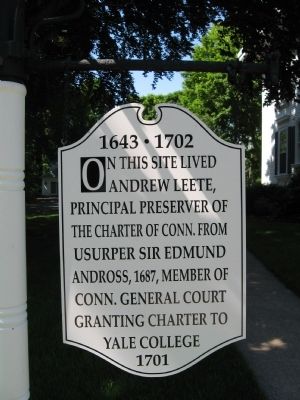On July 1, 2018, on probably the hottest day of the year, Marco and I explored some sites in Guilford. First, we strolled around the town green, which has paved walkways criss-crossing the nearly 12 acres of lawn and shade trees.
I was impressed with the beauty of the “park,” but Marco corrected me and said, “cemetery.” He was not pleased that the sacred Village Green Cemetery was disguised as a park and used for concerts, picnics and various other public activities. It didn’t bother me, but I would have liked to see a memorial recognizing the people whose bodies were buried there. Did we miss it, somehow? The tombstones were all moved many years ago, but the graves remain.

It was the first time we had been to a cemetery where both my ancestors and his are buried. Erik P.’s ancestors are here, too, and they were all part of the same community about 375 years ago. Marco and I have 15 ancestors there, combined; Erik has 4. I created “faux tombstones” for visual impact.
Barbara’s ancestors:
Aaron Blatchley and Mary Dodd are also ancestors of my cousin, Kristin. Aaron and Mary had 10 children; among them were my ancestor, Thomas, and Kristin’s ancestor, Samuel. Samuel married and established his family in Stamford, Connecticut.
Marco’s ancestors:
Erik’s ancestors:
Voyage to the New World
Marco’s and Erik P.’s ancestors came to Connecticut Colony in the company of Puritan minister Henry Whitfield. Whitfield himself was Marco and Erik’s 10th great-grandfather. They sailed over during the turbulence of the English Civil War, when Charles I and Archbishop William Laud exerted arbitrary injustice upon religious dissidents.
Prior to their arrival in the New World, male passengers signed a plantation covenant, pledging to live together in community. It became known as the Guilford Covenant and is similar to and perhaps as significant as the Mayflower Compact.
GUILFORD COVENANT – signed June 1639
We whose names are here underwritten, intending by God’s gracious permission to plant ourselves in New England, and if it may be, in the southerly part about Quinnipiack, do faithfully promise each, for ourselves and our families and those that belong to us, that we will, the Lord assisting us, sit down and join ourselves together in one entire plantation, and be helpful each to the other in any common work, according to every man’s ability, and as need shall require, and we promise not to desert or leave each other or the plantation, but with the consent of the rest, or the greater part of the company who have entered into this engagement. As to our gathering together in a church way and the choice of officers and members to be joined in that way, we do refer ourselves, until such time as it please God to settle us in our plantation. In witness whereof we subscribe our names, this first of June 1639.
Signers of the Guilford Covenant:
-
- Robert Kitchell – brother of Marco’s 10th great-grandmother, Lady Elizabeth Kitchell Rucke
- Abraham Cruttenden – brother of Erik’s ancestor, Elizabeth Cruttenden Graves
- John Housegoe
- John Mepham
- William Plane
- John Bishop – Marco’s 10th great-grandfather
- William Chittenden
- Thomas Jones
- Thomas Naish
- John Stone
- Francis Bushnell
- Henry Doude
- John Jordan – Marco’s 9th great-grandfather; brother of Erik’s 9th great-grandfather, Thomas Jordan
- William Noble
- William Stone
- Francis Chatfield
- William Dudley
- Henry Kingstone
- Thomas Norton
- Richard Guttridge
- Thomas Cooke – Marco’s 9th great-grandfather
- John Hoadley
- William Leete – Erik’s 9th great-grandfather
- John Parmarly – Marco’s 10th great-grandfather
- Rev. Henry Whitfield – Marco and Erik’s 10th great-grandfather
In 2014, Guilford memorialized its original covenant on an enormous granite slab which is on display outside the Whitfield House Museum. The rededication says volumes about the significance of the covenant and the original founding of Guilford to its current residents.

The Henry Whitfield House
The home, which is the oldest stone home in New England, also functioned as an emergency shelter for the town residents. Historians say that the construction of emergency shelter seemed prudent due to the recent Pequot War in 1637. Although the war was over, signs of it remained. For instance, during the war, one of the Pequot sachems was chased to Guilford and killed there in what became known as Bloody Cove. His head was lodged in a tree and remained there for years – the area is still known as Sachem’s Head. The scene did not exactly present a warm welcome to the newcomers. Pictured below is an artist’s rendition of the sachem’s head – I couldn’t avoid my shadow in the picture – which is on display at the Whitfield House.

An extraordinary statue of a very handsome Rev. Henry Whitfield stands directly outside the museum. Interestingly enough, there was no portrait of Whitfield, so his likeness was entirely a creation of the artist’s imagination.

For additional reading, I recommend the Connecticut Museum Quest, one of my favorite sites for its entertaining take on Connecticut history; and Miner Descent, another favorite.
The Menunkatuck Trail (now part of the New England National Scenic Trail (NET))
A spur of the NET enters the grounds of the Whitfield House and extends to the woods behind the barn. It offers a good opportunity to take in the beauty and history of the museum (and grab some water) near the beginning or the end of the trail, depending on where the hike begins. As someone who has trekked much of the NET, some of it many times over, I was thrilled to know this. Here are a few pictures of the spur.
Andrew Leete Historic Marker
The Honorable Andrew Leete (Erik’s 8th great-grandfather) played a fascinating role in Connecticut history. The story is well told by Connecticut Museum Quest, as well as Connecticuthistory.org, so I will simply summarize it briefly. Sir Edmund Andros was governor of the Dominion of New England until the 1689 Boston Revolt. His governance was supposed to include Connecticut, but then governor Robert Treat (Merle’s 8th great-grandfather) was stalling in submitting to Andros’ authority. Andros finally demanded the charter at a meeting in Hartford. Andrew Leete is credited with extinguishing the candles while Joseph Wadsworth ran away with the charter and hid it in the hollow of a huge oak tree. Since then, the charter oak has been an enduring symbol for Connecticut. The name has been used by a bank, college, vineyard, brewery and numerous other businesses.




















